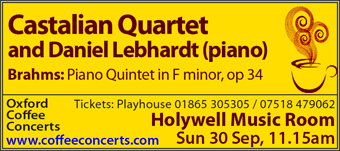By now, piano aficionados know that Daniel Lebhardt's arrival to play in
In my ignorance I had assumed the ensemble took its name from Hermann Hesse's great masterpiece of a novel from 1943, Das Glasperlenspiel [The Glass Bead Game], whose setting is Castalia, a fictional province of Central Europe, and one of whose major characters is the Music Master who recruits the protagonist Josef Knecht as a young student. But no: violinist Sini Simonen kindly put me straight. In Ancient Greece between c. 1400 BC and 83 BC, visitors to Delphi to consult the fateful Delphic Oracle, together with contestants in the Pythian Games (second only in prestige to the Olympics), came to refresh themselves and wash their hair in the Castalian Spring that flowed from a defile near the sanctuary there.
The Castalians began with Anton Webern's Langsamer Satz [Slow Movement] of 1905. It turned out to be a highly-charged work in the tradition of post-Brahmsian romanticism and tonality, demonstrating that Webern could escape the confines of Schönbergian atonal music when he so desired. The work, short as it is, managed to express a plethora of emotions - from yearning to dramatic turmoil and then on to a tranquil dénouement, the latter punctuated with little interventions by the cello.
The audience by now had had sight of the playing style of each of our four players and the interesting contrast they made one from another. Sinonen, the leader, likes to play with her violin held high and with eyes closed almost throughout, more or less eschewing the open score in front of her, while Charlotte Bonneton, often smiling, held her viola low and constantly scanned her fellow players, establishing visual rapport with them. Cellist Christopher Graves seemed deep in contemplation of the music, while the remaining violinist, Daniel Roberts, stayed relatively still and impassive in demeanour, though belying this appearance by playing his fiddle with great passion when the score required it.
When Daniel Lebhardt joined the quartet for the Brahms Piano Quintet in F minor op. 34 the composer immediately allowed him to make his mark in the form of a few deceptively mild bars before launching into a crunching running figure. This then led onto a winding melodic passage that, springing from classic Brahmsian fecundity of invention, was constantly varied while the overall theme lurked recognizably throughout the work. Later in the movement Mr Lebhardt laid out a passionate re-statement of the opening theme, and this was then decorated and developed by the four strings. As he played the material again and again, he managed at each repetition to produce a small increment of intensity but always without ostentation – not at all an easy thing to do.
In the Andante the middle section's arpeggios were immediately succeeded by a martial march in which the piano's upper register notes seemed to suggest bugle calls on the parade ground. Then in the Finale the moody opening was followed by quite a jaunty section, and here our ensemble showed its versatility by managing an authentically lighthearted feel otherwise wholly absent from the work. Late on, the experienced Brahms hand just knew that a big codal climax was coming. And so it did come, the main theme now transformed into a storm of staccato triplets, with syncopations being untangled only at the abrupt end, our five players having arrived there with energy level remarkably undiminished.
The thunderous applause suggested the audience around me had truly cleansed their minds – if not their hair - and refreshed their spirits this Sunday morning in the musical balm issuing from this Castalian spring.




